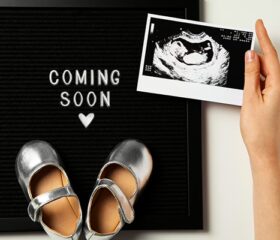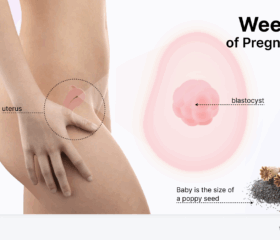Frequently Asked Questions about Calculating Your Due Date after IVF

- How do you calculate an IVF pregnancy due date?
- Why are IVF due dates calculated differently than “natural” due dates?
- What is the timeline for IVF treatments?
- Does fresh vs. frozen embryo transfer matter when calculating your due date?
- What is ICSI and will it affect your due date?
- How accurate is an IVF due date?
- Why is it important to know your estimated due date?
- Are IVF babies more likely to be early or late?
- How do you manage an IVF pregnancy?
- When will your pregnancy symptoms start after undergoing IVF?
How do you calculate an IVF pregnancy due date?
To pinpoint your estimated due date after undergoing IVF, you need to start with your embryo transfer date. You’ll also need to know the age of the embryo at the time of transfer, which will usually be three days or five days (post-fertilization). 1
Your fertility clinic will provide this information to you.
Calculating for a 3-day embryo transfer
If your embryo was transferred three days after fertilization, you can estimate your due date by adding 263 days to your transfer date.
You may have also seen other calculators that use a similar method: adding 266 days (which represents a full 38-week gestation from fertilization), and then subtracting 3 days. This is mathematically identical to simply adding 263 days—it’s a more complicated version of the same formula.
Our tool will perform this calculation for you when you select the “3-day transfer” option.
Calculating for a 5-day embryo transfer
For embryos transferred five days after fertilization (a period that’s known as the blastocyst stage), the calculation is slightly different. You add 261 days to your transfer date. (Here again, many calculators add 266 days and then subtract 5; this also amounts to the same thing.)
With our tool, if you select the “5-day transfer” option, it will handle this automatically.
Calculating for other scenarios
Occasionally, doctors perform IVF transfers with embryos older than five days. This is often the case with frozen embryos. 2
In these cases, to get an estimated due date, you have to subtract the embryo’s age (in days) from 266 and then add the resulting number of days to your transfer date.
If your pregnancy resulted from using donor eggs or donor embryos, the calculation often uses the date of egg retrieval. Count 266 days (38 weeks) from the egg retrieval date to estimate your due date.
Why are IVF due dates calculated differently than “natural” due dates?
In natural (non-IVF) pregnancies, you’ll normally calculate your due date from the first day of your last menstrual period (LMP). That’s because the exact date of ovulation and conception is hard or impossible to determine, whereas the LMP start date is usually a known quantity.
IVF pregnancies are different. Because the key dates (egg retrieval and embryo transfer) are known precisely, calculating your due date is more straightforward and the result is often more accurate.
Instead of using the date of your LMP to estimate when you ovulated (when one of your ovaries released a mature egg for fertilization), you can calculate from the exact date your embryo transfer took place.
What is the timeline for IVF treatments?
On average, the entire IVF process lasts about 4–6 weeks per round, including the time before egg retrieval. 2
You’ll often go through six steps before your doctor can confirm your pregnancy (assuming IVF is successful). The basic process is described below, although just as an example; your situation may differ somewhat from this scenario, depending on your circumstances. 2
- Birth control or estrogen: Your doctor may prescribe birth control pills or estrogen before you start treatment to influence the timing of your menstrual cycle. This will give them more control over your treatment and maximize the number of eggs they can retrieve.
- Ovarian stimulation: You’ll receive an injection of medication that will stimulate your ovaries to produce mature eggs. After an ultrasound and hormonal test, your doctor will administer a “trigger shot” to finalize the maturation of your eggs, usually around 36 hours before egg retrieval.
- Egg retrieval: Using an ultrasound, your doctor will guide a thin needle through your vagina into each of your ovaries. They’ll then pull your eggs out of each ovarian follicle. You’ll usually get medication to limit your discomfort during retrieval.
- Fertilization: After your procedure, your doctor will fertilize the mature eggs they retrieved. Usually, about 70% of them will be successfully fertilized.
- Embryo development: Over the next few days, your doctor will monitor the eggs until they develop into embryos. Around 50% of zygotes (fertilized eggs) make it to the blastocyst stage.
- Embryo transfer: Around 14 to 21 days before your transfer date, you’ll receive hormones that will prepare your uterus for pregnancy. If your uterus is ready, your doctor will transfer one or more viable embryos via a catheter.
If the embryo successfully implants into your uterine lining, you’ll get pregnant, which your doctor will determine with a blood pregnancy test 9–14 days after the procedure.
You may experience light spotting after implantation
Many women get light spotting when the egg implants in the uterus, known as implantation bleeding. Implantation bleeding has a much lighter flow than a typical menstrual period.
Does fresh vs. frozen embryo transfer matter when calculating your due date?
Whether your transfer involved a fresh embryo or a frozen embryo transfer (FET) doesn’t affect how your due date is calculated. Your due date is based on the transfer date and embryo age.
The timing of a FET cycle might be adjusted based on your uterine lining’s readiness, but the due date calculation itself relies on the actual day of transfer and the embryo’s developmental stage.
What is ICSI and will it affect your due date?
Intracytoplasmic sperm injection (ICSI) is a type of IVF where your doctor inserts sperm directly into your egg to improve the chances of fertilization. In contrast, in “typical” IVF procedures, they allow the sperm to penetrate the egg naturally.
ICSI is common. Around 6 out of 10 IVF procedures involve it. 3
Doctors usually opt for ICSI when male infertility is the driving factor behind a couple’s trouble conceiving. For instance, if your partner’s sperm has lowered mobility, ICSI can bypass this issue. 3
However, although ICSI does increase the chances of successful fertilization, it won’t have an impact on your due date.
How accurate is an IVF due date?
While IVF due dates are generally more accurate than estimates based on your last menstrual period, all estimated due dates are still just estimates. Your EDD isn’t a guaranteed birthday for your baby.
In fact, only around 5% of babies are actually born on their exact estimated due date (EDD), whether they were conceived via IVF or naturally. 4 It’s more common for babies to arrive a week or two before or after their EDD.
Think of your due date as the center of a window spanning from week 37 to week 41 of your pregnancy during which your baby is most likely to enter the world. Even that isn’t guaranteed; a minority of babies are born outside this window.
Why is it important to know your estimated due date?
Even though it’s only an estimate, there are plenty of reasons it’s worthwhile to know your EDD. It’s useful for:
- Monitoring growth: In your regular prenatal checks, your doctor will use your baby’s gestational age (calculated from the EDD) to assess if she’s growing at an appropriate rate. This will help identify whether she’s smaller or larger than expected for her stage. It will also help them gauge whether she’s hitting her developmental milestones on schedule or not.
- Assessing term status: When your baby is born, her EDD will help determine whether her birth is preterm (before 37 weeks), full-term (typically 37–40 weeks), or post-term (after 41–42 weeks). This will influence the medical care she gets immediately after she’s born.
Are IVF babies more likely to be early or late?
Generally, a single baby conceived via IVF isn’t inherently more likely to be early (or late) compared to a spontaneously conceived baby unless other risk factors for preterm birth are present.
The perception that IVF babies often arrive early might stem from the historically higher rates of multiple births (twins, triplets) associated with IVF. Transferring more than one embryo used to be more common to increase success rates, and multiple pregnancies carry a significantly higher risk of preterm labor and delivery.
However, with the trend towards single embryo transfers, this association is less pronounced for singleton IVF pregnancies.
What factors affect the risk of preterm birth?
Factors that do increase the risk of preterm birth (regardless of conception method) include: 5
- Carrying multiples (twins, triplets, etc.)
- Having a history of previous preterm birth
- Certain maternal health conditions (like high blood pressure or diabetes)
- Certain pregnancy complications
- Maternal age (being very young or over 35)
How do you manage an IVF pregnancy?
If you conceived via IVF, your doctor may want to monitor your pregnancy more closely than they otherwise would. This might involve extra check-ups or scans, such as a detailed look at your baby’s heart around 20–22 weeks.
In some situations, particularly if certain risk factors arise, your doctor might discuss the possibility of inducing labor as you approach or pass your due date. 6
Induction is not a given for all IVF pregnancies. Your doctor will decide whether to induce labor based on the health and safety of both you and your baby. Always discuss any potential interventions and your preferences with them.
When will your pregnancy symptoms start after undergoing IVF?
Wondering when you’ll start “feeling” pregnant? Just like in non-IVF pregnancies, the timing and intensity of early pregnancy symptoms after IVF vary widely.
Some early symptoms, like the infamous morning sickness, can show up about 4–6 weeks after you become pregnant, or even sooner. 7 Others will likely set in later. For instance, pregnancy cravings often start later in the first trimester and peak in the second trimester.
However, while many women get those early pregnancy signs, you might not have any noticeable symptoms at all. Every pregnancy is different, so try not to compare yourself too much to others.
Article Sources
- International Journal of Reproduction, Contraception, Obstetrics and Gynecology. "Comparison between sequential transfer vs. day 3 and day 5 frozen embryo transfer in IVF patients" Retrieved August 5, 2025.
- Cleveland Clinic. "IVF (In Vitro Fertilization)" Retrieved August 5, 2025.
- Cleveland Clinic. "Intracytoplasmic Sperm Injection (ICSI)" Retrieved August 5, 2025.
- Tommy’s. "Pregnancy due date calculator" Retrieved August 5, 2025.
- March of Dimes. "Preterm labor and preterm birth: Are you at risk?" Retrieved August 5, 2025.
- Cleveland Clinic. "Induced Labor" Retrieved August 5, 2025.
- Tommy’s. "Earliest signs and early symptoms of pregnancy" Retrieved August 5, 2025.







